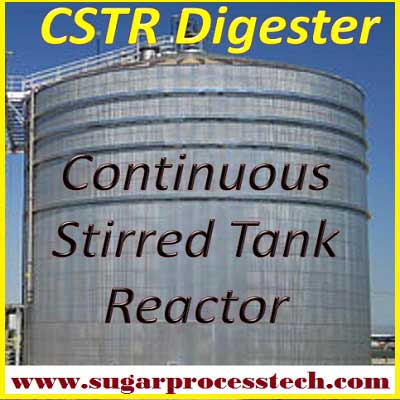In this section, Fundamental concepts of CSTR ( Continuous Stirred Tank Reactor) or Anaerobic Digester like its terminology, reactions involved in digester, design criteria and working operation and parameters.
CSTR Digester | Anaerobic Treatment for Raw Spent wash in Distillery
Terminology used in Digester ( Biomethanation)
Chemical Oxygen Demand (COD)
Oxygen required for the complete oxidation of biologically degradable and non-biodegradable organic matter. The organic matter in reduced state such as Cl, CN, and NO3 also get oxidized.
Biological Oxygen Demand (BOD)
BOD is the oxygen quantity demanded by the aerobic micro- organisms (bacteria) to stabilize the organic matter. Since BOD is directly proportional to the organic matter concentration.
Total Solids
The amount and nature of dissolved and undissolved matter present in liquid very greatly. In potable waters most of the matter is in dissolved form and consists mainly of inorganic salts and small amount of organic matter.
The amount of undissolved colloidal and suspended matter increases with pollution. Sludge represents extreme cases of pollution which most of the solid matter is undissolved.
Anaerobic Digester
Organic materials are decomposed biologically by various species of bacteria. Bacterial decomposition can occur without air in anaerobic digester.
These bacteria are Acetogenic bacteria and methogenic bacteria.
Acetogenic Bacteria
Acetonic bacteria are described as non-methanogenic (or) simply they are called as ‘acid formers ‘. Among the non-methanogenic bacteria that have isolated from anaerobic digesters are clostridium, lactobacillus etc.
Methanogenic Bacteria
Methanogenic bacteria are simply called as methane formers. They are strictly called anaerobes. Methanogenic bacteria are H2 utilizing bacteria (methnospirillum hungates) and acid utilizing bacteria.
Biogas
Biogas produced from Anaerobic digester consists of CO2 (38 to 48 %), CH4 (50 to 60 %), H2S (1 to2 %). The biogas has a high calorific value – 4500 Kcal / m3.
This is directly sent to the boiler as fuel for steam generation. Also Biogas used for gas engine after removing H2S from biogas.
Description Of Anaerobic Digester
CSTR Digester consist of continuous stirred tank reactor where continuous mixing of effluent and biomass take place with the help of central and lateral agitators.
The essential feature of that the wash out of the active anaerobic bacterial biomass from the reactor is controlled by a sludge separator recycle system. The basic idea underlying the anaerobic contact process is that;
- Provide contact between the active biomass and feed.
- Utilize the digester volume effectively.
- Prevent stratification and temperature gradient
- Minimize the formation of scum layer and the deposition of sludge solids.
Basic reactions in CSTR system
Anaerobic digestion is performed by two groups of bacteria.
Acid producing bacteria :- Acid forming bacteria – butyric & propionic acid & Acidogenic bacteria – acetic acid & hydrogen
Methane producing Bacteria :- Acetoacetic bacteria (Actophillic) & Methane bacteria (Hydrogen phallic)
Basically three stages are involved in the process of anaerobic digestion
Hydrolysis: It is a process of suspended organics and soluble organics of higher molecular weight to simple organic molecule
Acidogenesis : Degradation of small organic molecules to various volatile fatty acid ultimately to acetic acid. The process of convertion of small organic molecule into acids is carried out by a group of anaaerobic bateria known acid formers.
Methanogenesis: Production of methane, primarily form acetic acid produced at the end of Acidogenesis process are converted into carbon dioxice and methane gases.
The process of conversion of acid into carbon dioxice and methane gases is carried out by group of anerobic bacteria known as methane formers.
Reaction
C6H12O6 3(CH3 COOH) (Acetic Acid)
3 CH3 COOH+ 3 NH4 HCO3 3 CH3 COONH4 + 3 H2O + 3 CO2
3 CH3 COO NH4 + 3 H2O 3 CH4 + 3 NH4 HCO3
Parameter of CSTR Digester
Raw Spent wash temperature : 38 to 42 0C
Temperature of digester : 38 to 40 0C
Digester inside pressure : 200 to 300 mmW
Digester PH : 7.0 to 7.5
Oxygen : Nil
COD load : 4 to 5 kgs/ m3 Of Digester area
COD Reduction across the Reactor : 65 ± 5 %
COD Reduction across the Reactor : 85 ± 5 %
Volatile acids of Treated spent wash : 1500-2000 mg/lt
Alkalinity of Treated spent wash : 16000 to 20000 mg/lt
CSTR / Digester Process
1 . Raw effluent is collected in a buffer tank and maintain the temperature around 38 to 42 oC. Some quantity of treated spent wash (Digeater outlet) also mixed in buffer tank to rise the pH.
2. From buffer tank raw spent wash feeded at top in a center shaft of digester
3. There will be one central agitator and two to 5 numbers of lateral agitators are available make uniform distribution of biomass and substrate for uniform degradation.
4. The effluent travels to the bottom and contact with active anaerobic culture in the reactor by the rotation of central agitator and lateral agitators.
5. The recirculated sludge also mixed with raw effluent in a central shaft of the digester
6. The treated spent wash collected through overflow pipe and passed through degassing tower for removal of dissolved gases to achieve better settling of sludge in further process.
7. Biogas collected at the top of the digester and will be stored in gasholder. Biogas from the biogas holder will be compressed and sent to boiler for burning.
8. Biogas also used for gas engine to generate power. Here H2S shall be removed from the biogas before using the gas engine.
Design Criteria of the CSTR system ( Anaerobic Digester)
Calculation of Biogas generation
As per the above Molecular Equation
Biogas generation in reactor = 0.53 ± 0.03 m3 of biogas produced from the one kg of COD reduced in effluent.
Take one example
Raw effluent feed rate to reactor – 18 m3/hr
COD of reactor inlet effluent – 120000 mg/lt
COD of reactor outlet treated effluent – 42,000 mg/lt
Reduction rate of COD – 78,000 mg/lt.
COD reduction rate in reactor = 18000 lt/hr x 78000 mg/lt. = 1404000000 mg/hr = 1404 kg/hr
Biogas production = 1404 kg/hr x 0.5 m3/kg = 702 m3/hr
Volume of the CSTR digester
COD Loading rate on reactor – 4 to 5 kg of COD /m3 /day
Take above example
Loading rate of COD on reactor = 120000 mg/lt x 18000 lt./hr
= 2160000000 mg/hr
= 2160 kg/hr = 2160 x 24 = 51840 kg/day
Volume required for reactor = = 12960 m3 ≈ 13000 m3
Thanks for reading this article “Concepts of Continuous Stirred Tank Reactor ( CSTR Digester )“. I Hope you liked it. Give feed back, comments and please share it.
Related Articles
Plate Heat Exchanger Heat Transfer Area Calculation
Biomethanation Technology for Treatment of Distillery Effluent
Calculation of ethanol yield from intermediate Products of sugar process
Methods for Industrial Effluent Treatment Plant


1 thought on “CSTR | Continuous Stirred Tank Reactor Design Criteria | Anaerobic Digester”
Dinesh Sharma
(April 24, 2019 - 5:31 am)I want to establish a biogas plant where i am having 2000kg/day of waste that includes 50-60% cow dung 10-12% food waste and rest is agriculture waste. I need to know about economic feasibility and return on investment so i can proceed further.
Thank you